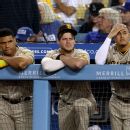Is Los Angeles Dodgers shortstop Trea Turner’s slide the prettiest play in baseball?
Turner #Turner

Aug 23, 2022
Jeff PassanESPN
Close ESPN MLB insiderAuthor of “The Arm: Inside the Billion-Dollar Mystery of the Most Valuable Commodity in Sports”
THE MOST BEAUTIFUL play in Major League Baseball exists because its practitioner embraced a long-held axiom: Form follows function. Once upon a time, Trea Turner was a habitual head-first slider, his fingers and wrists and shoulders exposed to all the obstacles that exist when a man launches himself toward stationary objects. As he continued to play — and to watch teammates and opponents alike get hurt — he couldn’t abide the risk. There had to be a better way, a safer way.
Turner had long studied other experts of the craft, a small fraternity of men who take baserunning every bit as seriously as hitting and glovework. He marveled at Terrance Gore, the stolen-base specialist who would slide at the last possible moment. Perhaps, Turner thought, there was a way to marry his inherent aptitude with a touch of Gore’s moxie in a feet-first approach. In 2020, when he was the shortstop for the Washington Nationals, Turner toyed and tinkered until he found something that really worked — and with it, a way to leverage his most elemental skills, this unique amalgamation of a sprinter’s speed, a larger man’s power, Gumby’s flexibility, a mathematician’s mind and a cat burglar’s daring.
The world did not take notice until Aug. 10, 2021. It was 11 days after the blockbuster trade that sent Turner and Max Scherzer to the Los Angeles Dodgers. Turner stood on second. Will Smith laced a single into right field. Bryce Harper fielded it clearly and unleashed a strong throw home. What happened next was form overshadowing function.
About 10 feet from home plate, Turner jumped. His right leg stuck out — he always slides right leg first — and his left leg tucked under his right, looking like a backward 4. By the time Turner landed, he was practically past home plate, except for his gloved left hand, which he matter-of-factly swiped across the dish. With momentum already pulling around his torso, Turner embraced the ride, popping up after a 180-degree spin and walking toward the dugout in one uninterrupted motion. The velvetiness, the effortlessness — the aura of the slide was born that day, even if the slide itself predated it.
“I’m not necessarily trying to be cool or anything,” Turner told ESPN in an interview last week. “It’s more that I’m trying to slide correctly — efficiently. I don’t slow down.”
All of that is true. Turner, now 29, never lays off the afterburners. He wouldn’t dare take for granted the position of his body in space. And even if he’s not necessarily trying to be cool or anything, the Trea Turner Slide very quickly became A Thing — and, overnight, became the standard by which slides were judged.
Few attempt to duplicate it, lest they be seen as poor imitations of a patented maneuver. Which, over the past year, it has become. In a sport with gorgeous swings and picturesque pitching deliveries, the humble slide has stolen hearts. Though perhaps that shouldn’t be quite as much of a surprise as it is.
ON DEC. 21, 1958, Gene Kelly joined the NBC show “Omnibus” to explain to viewers how dance and sports were far more alike than many realized. He asked Johnny Unitas to throw a football and Bob Cousy to play tight defense on the basketball court. When it came around to baseball, Kelly left the choice up to Mickey Mantle.
“Give us the most exciting thing to you in any baseball game,” Kelly said. “What would it be?”
“I think the most exciting thing for me in baseball,” Mantle said, “is trying to steal second base or taking an extra base and sliding in real hard.”

3d

8dESPN

16dAlden Gonzalez
2 Related
Much as Kelly tried to replicate Mantle’s and make it resemble dance, the slides of the 1950s were far grittier than the brand typically employed today. Runners intentionally went in spikes up. Breaking up double plays wasn’t just encouraged but mandated. Slides were sometimes slides and sometimes messages. Injuries went both ways.
Kelly would swoon at what today’s game offers, where creativity, spawned by Turner and his peers, abounds. The swim move, in which a slider offers an arm for a fielder to tag, then pulls it back and reaches around with another, is popular. Longtime utilityman Chris Coghlan once leapt over Yadier Molina entirely, touching home plate on his frontflip. The inability to take out a second baseman or catcher has necessitated players rely more on their skills. Turner embodies it, prompting those around him to lavish praise.
“You’re looking at something that’s really spontaneous — a movement that brings back the whole idea of letting yourself go and not caring you’re going to get dirty and tear up your uniform,” said Jeffrey M. Katz, the author of “Plié Ball,” a book that explores the intersection of baseball and dance. “When you see a beautiful slide, you have a feeling there’s a thought process behind it. There’s something deliberate — a sense that whoever’s doing it understands that not only is it going to get him where he needs to go, it’s almost a performance. It’s something people are observing. You’re putting your creativity into it and giving fans something to enjoy. It’s a natural finesse.”
There is a universality to a Trea Turner Slide, an aesthetic that appeals to anyone who has tried to salvage a fall with a slick recovery. (In other words, every single one of us.) Turner’s falls may be intentional and controlled, but it doesn’t lessen the magnificence of the finish, like a gymnast sticking the landing or a stunt driver gliding into a narrow parking spot.
“Music in motion is kind of a trite saying,” Dodgers manager Dave Roberts said, “but it’s just the ultimate grace and body control with the power of creating speed. And so to be able to slide and naturally stand up — that takes a lot of speed and body control. And I don’t think people appreciate how hard it is to do but it speaks to what an athlete he is.”
Robert Hanashiro-USA TODAY Sports
“It’s the distance he covers and then how he just drops his hand in and puts it perfectly on the plate and then just pops up like nothing ever happened,” Dodgers first baseman Freddie Freeman said. “It’s just a beautiful thing to watch. It really is beautiful.”
Beautiful enough, certainly, to warrant inclusion on a dance show — except for the fact that Turner wouldn’t ever get anywhere near one. In 2019, on the way to their World Series championship, the Nationals developed a celebratory tradition: Every time a player hit a home run, upon his reentry into the dugout, he needed to dance.
“It was my worst nightmare,” Turner said.
Turner … well, Turner can’t dance. Once, he tried to do a simple groove in the dugout and was a touch Elaine-ish for everyone’s taste. Another time, he attempted the “Apache” dance from The Fresh Prince of Bel-Air. The hip thrusts were messy. The 360 in the dance wasn’t nearly as natural as his 180 on the slide.
“I work out at the same place every offseason. I work on form,” Turner said. “When the guy I work with tells me how to move, I get really uncoordinated really fast. But if you tell me go over there and catch this ball, I have a simple goal and my body moves a little bit better. Dancing is not for me.”
Good thing pretty much everything on the baseball field is.
IN THE PAST, when he had some spare time, Trea Turner liked to build things. He went to North Carolina State as a severely underrecruited baseball talent, as well as someone who took his academics seriously enough that he planned to major in chemical engineering. That left-brain desire to fabricate spilled over to computers. Turner watched a YouTube video and assembled one. After that, he put together a couple more without any tutorials.
That sort of structured approach to his game has brought Turner to places well beyond those of someone who just slides pretty. He is one of the best players in baseball. Turner is one hit behind Freeman for the major league lead. If he passes him and holds on to the lead, Turner will be the first player in baseball history to outright lead the entire major leagues in hits over three consecutive seasons. (Ichiro Suzuki won five consecutive hit titles, but he tied with Dustin Pedroia for the third.)
Few can match Turner’s combination of power (18 home runs) and baserunning acumen (20 stolen bases). His speed remains the most consistently excellent in the whole game, bursting 30-plus feet per second as he approaches 30 years old.
“I’m young. I’m fresh,” Turner said. “I am getting older compared to how young the game has gotten. I’m just trying to keep up with the 22-, 23-year-olds.”
With good reason: Turner will hit free agency for the first time this winter and face no shortage of suitors. His most similar batter, according to Baseball-Reference: his former Dodgers teammate Corey Seager, who fetched a $325 million deal last winter. Turner is older. He doesn’t hit for quite the same power. But the weaknesses in his game are limited, and his desire to stay healthy and play every game this season — he’s 121 for 121 so far — suggests Turner’s safe-slide strategy is doing its part.
There are still mysteries to it, best left to curious physicists and number crunchers. Even Statcast can only quantify it to a point — sure, Turner ranks first in the majors this year in 30-plus-foot-per-second runs with 100 (24 more than the next best, Bobby Witt Jr.) and second in sprint speed, at 30.3 (0.1 seconds behind the leaders, Witt and Jose Siri). The difficult-to-measure elements provide the real mystery. Why, for example, does Turner slide as if friction does not exist for him? Mere mortals stop when they launch themselves onto grass or dirt, and Turner keeps gliding like the rules of the universe don’t apply — or as if he controls his weight so exquisitely that he renders them a nonfactor. Or is it the length of the slides themselves, as Freeman suggested, that makes Turner’s so beautiful? Is he actually sliding multiple feet farther than his fellow players?
The answers don’t matter to Turner. As left-brain as he might be in planning out his future, on the field his right-brain takes over. Baseball is a creative game. It’s why a few weeks ago, he busted out the famous slide chasing down a pop-up in foul territory that looked far out of reach. He caught the ball and smooth-landed the slide, of course.
“I’m trying to be good at everything,” Turner said. “I want to be a good defender. I want to be a good hitter. I want to be a good baserunner. And I’m trying to improve on all of those things.”